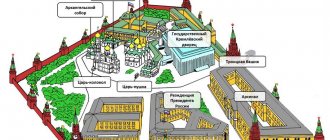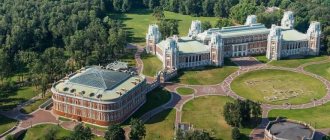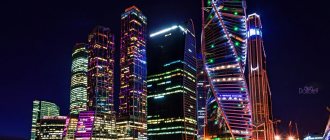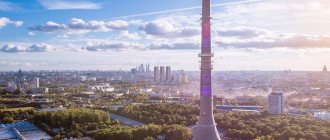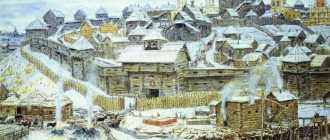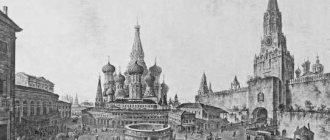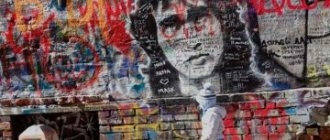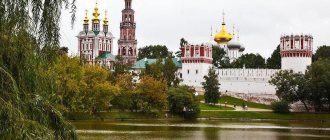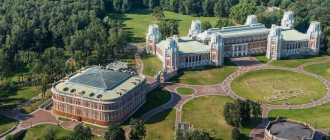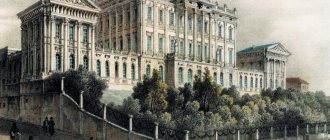Start of construction
Plans and reality
Construction of one of the most famous television and radio towers in the world began in Moscow during the civil war, in 1920. It was a time when the country was torn apart by internal political contradictions, armed conflicts and economic ruin. But it was precisely during this difficult time for the country that Lenin personally ordered the construction of a radio tower to connect the center with the outskirts of the country and other states.
The first project for such a grandiose structure was provided by the Russian scientist, architect and brilliant inventor Vladimir Grigorievich Shukhov in 1919. As a radio antenna, he proposed building a tower of 9 sections with a total height of 350 meters. It was assumed that it would weigh more than 2,000 tons. It was also planned that the Shabolovskaya Tower would be built in a maximum of a year.
If we take the Eiffel Tower for comparison, it is 305 meters high and weighs 8,000 tons. The originality of the Russian ingenious project was that the Shukhov TV tower was supposed to be taller than the Eiffel Tower, but at the same time almost 3 times lighter.
But the Russian state was not going through the best of times: the country was ruined. There was not enough food for the people, and one could only dream of materials for such a large-scale construction project. The main problem was that in a country in such a difficult situation, it was difficult to find so much metal.
Therefore, Shukhov was allowed to build only a 150-meter tower weighing 240 tons. And even with such reduced dimensions, the required amount of metal was taken from the Military Department fund only by personal decree of Vladimir Ilyich Lenin.
But it was not enough to come up with the design itself. It was necessary to develop a construction method. After all, there were no working tools, there were no cranes capable of delivering materials to workers to such a height.
And then the brilliant architect Vladimir Grigorievich Shukhov proposed an extraordinary solution. He developed a method of construction work in which the upper sections were made inside a ready-made lower structure. And then, using simple winches, the sections were lifted and placed on top of each other.
Work on the construction of the high-rise began on March 14, 1920. Builders were exempted from conscription into the army and provided with rations for Red Army soldiers. But the conditions were difficult. Everything had to be done in the shortest possible time, so half-starved people had to work a lot.
But... Russian people, Russian spirit - nothing can change this! The work was carried out according to plan, and the tower invariably “grew”.
When even metal gets tired
But tragedy struck. On June 29, 2021, while lifting the fourth section, the third broke. Falling, they partially destroyed the second and first sections. A special commission to investigate the causes of this failure concluded that the design itself was flawless, and the cause of the incident was “metal fatigue.”
But, despite this, the chief architect Shukhov was arrested and, as he himself later said, sentenced to conditional execution. This meant that if during the further construction of the tower any other emergency had occurred or the tower had not been put into operation by the deadline, then the sentence would have been carried out.
Fortunately, everything worked out fine. A year later, the tower was completely built.
The years of its construction are 1920 -1922. It was light, but very rigid and durable construction.
The round body of the tower consisted of 6 sections 25 meters high. Each tier is a hyperboloid of rotation, that is, a three-dimensional structure that consists of straight steel beams. All tower elements are fastened with rivets in the form of steel rings.
Interestingly, it was the Shukhov TV Tower that inspired the famous writer Alexei Tolstoy to create the science fiction novel “Engineer Garin’s Hyperboloid”.
Design Features
The architecture of the building can be confidently called bold and innovative. This is a hyperboloid structure in the form of a steel mesh shell.
A hyperboloid in architecture is a special linear rigid structure. In the Shabolovskaya Tower it is brilliantly laconic. Presented in the form of straight steel profiles intersecting each other. These profiles are based on strong bases - rings, creating a clear geometric pattern - a grid.
At first glance, this mesh structure is very fragile. But it has an invaluable advantage - the wind load on it is minimized . For a structure made entirely of metal beams, the Shukhov Tower has a record low weight.
Simplicity and practicality are felt in everything; the details did not require special development and consisted of rivets and profiles.
For the first time in Russia
First radio broadcasts
Immediately after the completion of the construction of the Shukhov TV tower on Shabolovka, it began to function. Radio transmitters with a power of 100 kW were installed on the tower, which could transmit a signal over a distance of up to 10,000 kilometers. This signal power exceeded the power of the television towers in Paris, Berlin, and New York.
The first broadcast from the radio tower in Moscow (according to the historical facts known to us) was a concert of Russian music with the participation of the famous opera singers of that time N. Obukhova and B. Evlakhov. This was a great event for the country, and March 19, 1922 marked the beginning of a new era of radio.
All charges against Shukhov were dropped and he was awarded the title of Honored Worker of Science and Technology, and a little later he received another title: Hero of Labor.
The birth of Russian television
The first television broadcast in the capital of the Soviet Union took place on March 10, 1939. On this significant day, the Shukhov Tower on Shabolovka broadcast a film telling - oh! No! — SHOWING the opening of the 18th Congress of the CPSU(B). It was a stunning, grandiose event for the Soviet country and its inhabitants!
Since then, broadcasts from the Shabolovskaya TV tower have taken place as planned: 4 times a week. The broadcast lasted 2 hours. Only a lucky few - owners of TK-1 TVs - could enjoy watching programs. For reference: the screen size of this one of the first Soviet televisions was 18x24 centimeters!
In the 50s of the 20th century, the Moscow TV tower on Shabolovka became a symbol of a new era. As a screensaver, her image was used before the start of the most popular programs, such as the unsurpassed “Blue Light”.
And a little later, this symbol of Russian television decorated our TV screens in the mornings, before the start of the broadcast.
Excursion programs
The Shukhov Tower on Shabolovka is currently closed. Renovation work is underway, so all internal excursions that were held when it was operational have now been cancelled.
The Shukhov Foundation still operates today. He has already collected a large sum for repair work, but continues to collect from everyone. The Foundation for the Development of Science and Culture is also raising funds.
As the engineering monument is restored and put into operation again, tourists will probably be able to visit the territory of the TV tower again. But today the only way to see it is from the outside. Many people prefer to visit places in Moscow near the tower in the evening to see the view of the city at night and the illuminated tower.
Some agencies conduct walking tours around Moscow, and the routes often take place in places close to the location of the Shukhov television tower.
Excursions for schoolchildren
Since the Shukhov Tower is temporarily closed for repair work, schoolchildren can see it during one of the sightseeing tours of Moscow, namely in Zamoskvorechye.
During one of the excursions, schoolchildren can visit:
- Tretyakov Gallery;
- Marfo-Mariinskaya monastery;
- House on the embankment;
- temples;
- museums;
- fountains.
An example of one of the walking excursions for large groups of children is “Reserved Zamoskvorechye”. The path passes through the narrow streets of merchant Moscow; city guests will see Streltsy chambers and apartment buildings. You can study the architecture of buildings of that time while walking, their facades, construction.
Along the way you will meet such attractions as the Zaryadye Chamber Museum, the Tretyakov Gallery, the Church of the Resurrection of Christ, and the Adam and Eve fountain. Along the way, the tourist group will be able to see the television tower in Shabolovka.
| Duration of the excursion | Price | Number of persons |
| 2-3 hours | 4,000 rub. | Up to 20 people |
| Guide | Telephone | |
| Elena Neganova | + 79263316303 | |
There are special excursions for children around Zamoskvorechye, organized by agencies. During the excursion, children visit the main attractions and have the opportunity to see the Shukhov TV Tower.
One of these organized excursions involves visiting the Tretyakov Gallery, visiting craft houses of the 17th and 18th centuries, houses with painted windows, viewing ancient buildings and studying their facades, visiting gardens and fountains. During the excursion, we visit the house where the heroes of Oblomov lived.
This tour is designed for children aged 5-13 years. It is recommended to register in advance and check available dates.
| Duration of the excursion | Price | Agency |
| 1.5-2 hours | 450 rub – per person | “Walking around Moscow” +7 (495)3645064 |
Don’t miss the most popular article in the section: Belgorod Fortress in Belgorod - why it’s unique, historical facts and excursions.
Excursions for adults
An example of a tourist excursion program is “Around and around the Shukhov Tower.” This is a walking tour of the historical district of Moscow with its own atmosphere. During the walk, the guide tells guests of the city about historical facts related to structures, monuments or buildings in the area.
The path starts from the "Nine Corners Square" and goes to the "England" area, where you can see replicas of British national symbols. Tourists walk past the building of a perfume factory that once produced the famous Red Moscow perfume. The path then leads to the mint. The guide will teach tourists how to navigate the Khavsko-Shabolovsky labyrinth.
The path will pass by constructivist objects, including the Shukhov TV Tower. The route also includes a gastronomic part of the excursion. In this vein, city guests visit the Danilovsky Market. Here you can find famous dishes and products from various cuisines of the world: Vietnamese, Australian, Dagestan, Italian and others.
It will be possible to try and purchase farm products, fresh vegetables and fruits, natural drinks, as well as black dumplings, nutria burgers, venison and other delicacies. An experienced guide will help you bargain and choose the best quality product.
The path also passes through mysterious places, for example, the Old Don Necropolis. Here you can be in silence, plunge into the Moscow of bygone times, and see examples of Russian architecture. The guide will enlighten tourists to some of the mysterious stories associated with the monastery and explain how they can decipher the Masonic signs left here.
At the end of the program, tourists will be taken to a place that combines the interiors of the Kremlin, theaters, prisons and a bit of a communal apartment. In such a picturesque place, nurses and police officers will serve guests as waiters. Here, after your hiking trip, you can refresh yourself with delicious dishes and discuss what you saw.
The guide will be happy to tell you how to spend the remaining time in Moscow in the most interesting way.
| Duration of the excursion | Price | Number of persons |
| 4 hours | 6,800 rub. | Up to 4 people |
| Guide | Telephone | |
| Natalya Nagaeva | + 79771366887 | |
Another option for a walk that combines gastronomic pleasures with sightseeing is the “Selfie with Moscow” tour. The path will pass by historical buildings of past centuries.
The tour passes by tall bell towers and other unique places in the capital, where you can take memorable photographs of yourself and your friends against the backdrop of the sights. On the way, city guests will see the Marfo-Mariinsky Convent, Muzeon, fountains on the drainage canal and “Adam and Eve”, the Tretyakov Gallery, as well as churches - the Resurrection of Christ and the Church of Clement of the Pope.
To try traditional Russian cuisine in an atmospheric Oblomov-style mansion, guests will go to a special restaurant. There is a stop at a mystical bar, where any cocktail without a menu will be made to suit the guest’s mood. The tour ends on the roof of a high-rise building with panoramic views of the capital. Here, in the cafe, guests can relax and make further plans.
| Duration of the excursion | Price | Number of persons |
| 4 hours | 6,800 rub. | Up to 4 people |
| Guide | Telephone | |
| Natalya Nagaeva | + 79771366887 | |
Aircraft accident and strength test
The extraordinary durability and strength of the Shukhov design can be judged by one incident that happened in 1939. On the Kiev postal plane, something went wrong in the air, and it began to fall. Flying quite low near the tower, the plane touched a cable that was stretched from the high-rise during repair work. The plane tore out the cable, crashed into the tower and, after flying some distance, fell to the ground.
A commission urgently met to assess the extent of the damage to the “high celebrity” and immediately begin repairing them. But it turned out that no repairs were required to the Shukhov hyperboloid tower. The TV tower on Shabolovka didn’t even notice the “meeting” with the plane!
War and post-war years
In 1941, due to the Nazi offensive, the equipment of the Shukhov skyscraper was completely dismantled and removed from Moscow, and the Shukhov Tower itself in Moscow was prepared for explosion. Fortunately, nothing needed to be blown up. And after 3 years, all the necessary equipment returned to Moscow to its original place.
Broadcasting was resumed in a short time. And on Radio Day, May 7, 1945, the first post-war broadcast of the Moscow television center was broadcast.
This continued until 1967, when the Ostankino Tower was built in Moscow. All this time, the Shukhov tower worked flawlessly. The creation of a Soviet engineer, thanks to its mesh shape, had increased resistance to the destructive power of winds. And this is very important for such tall buildings. And this is another of her genius.
Broadcast history
During the initial period of operation, the Shukhov Tower was used to broadcast radio programs. Its broadcast radius was greater than that of radio stations in New York, Paris and Berlin. In 1927, the radio station was modernized, equipped with the most powerful 40-kilowatt transmitter in Europe. It became known as the “Comintern Radio Tower”.
Later, television antennas were installed on it, and buildings were built nearby to house equipment, a studio with an area of 100 m2, and transmitters with a range of up to 60 km. The television period of operation of the tower began in 1939. At that time, television broadcasts were conducted four times a week for two to three hours, and the number of home televisions in Moscow did not exceed hundreds. The image on their screens, of course, was far from what it is today, not to mention the color.
With the beginning of the Second World War, television broadcasts stopped, and the tower returned to its function as a radio transmitter in the capital. As the Nazis approached Moscow, the equipment of the structure was dismantled and taken away, and the structure itself was prepared for explosion. A corresponding order was even given, failure to comply with which in wartime conditions was punishable by execution. However, the executor of the order, the head of the laboratory of the People's Commissariat of Communications, Alexander Shchetinin, showed enviable composure and waited until the enemy was defeated near Moscow.
In the year of Victory, the equipment was returned and television broadcasts resumed (the first in Europe). The mesh structure of the tower became the logo of Soviet television, which preceded the start of the broadcast. The traditional “Blue Light” was also filmed against its background. The studio in Shabolovka imitated a cafe, on the wall of which hung a banner depicting a tower taken from a lower angle.
Fragment of the program “Blue Light”
A study carried out in the post-war years confirmed the good technical condition of the tower. Maintenance was limited to anti-corrosion painting. In 1958, next to the Shabolovskaya tower, another one was built - an ordinary 110-meter one to provide two-program broadcasting. It worked for 30 years, after which it was dismantled.
In 1967, the status of the main television broadcaster in Russia passed to the built Ostankino Tower. Shabolovka became a backup television tower used for outside broadcasts. But after the fire in Ostankino in 2000, during the two-year period of eliminating its consequences, the Shukhov TV tower again took over the entire volume of television broadcasting.
A little about the author of the masterpiece
Youth of a genius
Vladimir Grigorievich Shukhov was born on August 28, 1853 in the Kursk province. A future scientist, inventor, architect, a talented person in many fields and... simply a universal genius.
True true! While still studying at the gymnasium, at the age of 13 he found his own way of proving the Pythagorean theorem! Incredible, right?! But when he presented it to the teacher, he praised the high school student for his originality and short proof, understandable to everyone. But he still lowered the estimate, citing the fact that Pythagoras lived 2,000 years ago and, respecting this, it was necessary to first convey his proof.
Vladimir Grigorievich Shukhov made his first invention at the Moscow Technical School, where he entered immediately after high school. He invented the nozzle for steam boilers, which later became very popular in its field. In addition, a few years later, Shukhov’s nozzle graced the cover of one of the books of the well-known Dmitry Mendeleev.
Shukhov's inventions - miracles of the 20th century
Shukhov's radio tower on Shabolovskaya brought him worldwide fame, but it was far from the first in a long list of his inventions.
Shukhov's first hyperboloid tower, consisting of metal mesh shells, was presented by the architect to the public in 1896 during an industrial exhibition. The light, tall, elegant, but quite strong and stable structure was appreciated by the audience. It immediately attracted the attention of visitors.
The owner of factories and glass factories, Yuri Nechaev, was especially interested in the extraordinary structure. At the end of the show, he purchased the design he liked. It was a 37-meter Shukhov water tower with a water tank and an internal spiral staircase leading to the upper viewing platform.
The estate of Yu. Nechaev was located in the Lipetsk region, in the village of Polibino. For transportation, the structure had to be disassembled and assembled on site. These works - disassembly and assembly - were personally supervised by the future author of the radio tower project on Shabolovka.
On the Shukhovskaya estate, they began to use the water tower to water a large, beautiful park, where the graceful, openwork structure looked very good. By the way, the tower is still located in the same place: in the village of Polibino. True, it is no longer in such brilliant condition as 120 years ago.
Soon, Vladimir Grigorievich patented his developments of such towers, which used the principle of a hyperboloid mesh structure. In general, Shukhov created more than 200 such high-rise structures - these are water towers, ship masts, supports for electrical lines.
Today, only a few of these high-rise buildings have survived. One of them is located on the Oka.
There are Shukhov hyperboloids in Kazan, Nikolaev, Borisov, Vyksa. Today in Russia there are 8 towers built in the Shukhov style. The researchers did the math and it turned out that Vladimir Grigorievich Shukhov created more than 200 hyperboloid towers during his life.
Shukhov is also the author of many more ingenious inventions in other various fields: the Moscow water supply system, railway bridges, docks for ship repairs. It was Shukhov’s inventions that formed the basis of the oil and gas industries: tanks for storing oil, devices for lifting black fuel from great depths, continuous pumping of oil and obtaining different fractions from it, including gasoline.
By the way, the landing stage at the Kievsky railway station in Moscow is also the development of the scientist Shukhov.
And this is what the building looks like today.
A similar structure can be seen under the arches of GUM in Moscow. There are also coverings of Shukhovsky’s inventions in the buildings of the Central Department Store, Petrovsky Passage, the Metropol Hotel and other buildings.
The engineering developments of the great scientist-genius were used not only in past years. For example, Shukhov’s ideas of hyperboloid structures are also used in the design of new Moscow City skyscrapers.
Vladimir Grigorievich Shukhov made a huge contribution to Russian culture and the development of Russian industry. According to experts, his name was a guarantee of quality. If Shukhov participated in the development of the project, it was believed that this structure would stand and work for a very long time.
As his contemporaries said about him, he is a man-factory. He constantly invented something, generated new brilliant ideas and found extraordinary solutions for his projects. But Vladimir Grigorievich did not devote all his time to engineering.
Personal life and hobbies of Vladimir Grigorievich
He had a large family: wife and children (2 daughters and 3 sons), and of course, grandchildren. Now the great-grandson of the first engineer of Russia lives in Moscow.
If we read the short biography of the architect of the Shabolovskaya Tower, we learn that Vladimir Grigorievich was very fond of playing sports: skating, skiing, archery. At one time he was a champion among cycling enthusiasts.
Shukhov loved photography very much. He was very interested in working with light, finding the most interesting angle for his photographs. His diary has even been preserved, in which he wrote to himself: “I am an engineer by profession, and a photographer at heart.” A multi-talented person! In memory of his great ancestor, his great-grandson still keeps photographs taken by Vladimir Shukhov, as well as his silver badge of the international cycling society.
For many years the inventor lived in the Chistye Prudy area: in Arkhangelsky Lane in Moscow in house No. 13, which was built on the site of the Frolov-Bari mansion.
Now it is a 5-story building, which was completed in the 1940s. You can discern at the base the former 2-story mansion, on top of which an additional 3 floors with bay windows and balconies were built. And nearby there are two amazing churches (now they belong to the Antioch courtyard of Moscow): the Temple of the Archangel Gabriel or Menshikov Tower and the Temple of Theodore Stratilates.
This house number 13 in Arkhangelsky lane. recognized as a historical and cultural monument, as evidenced by a special plaque. It is located on the side of the house from Krivokolenny Lane.
Vladimir Grigorievich Shukhov died at the age of 85 on February 2, 1939. The universal engineering genius was buried at Novodevichy Cemetery: plot 2, row 40.
In Moscow, on Sretensky Boulevard in 2008, a bronze monument to this great man was erected with funds.
In addition, near the Melnikov Institute in Moscow there is a bas-relief dedicated to the architect, engineer and greatest scientist Shukhov. An interesting fact is that Vladimir Grigorievich transferred all rights to his inventions, as well as the royalties received, to the Soviet state. I wonder, if the USSR no longer exists, then who owns the authorship of all the discoveries?
A few more great designs by Shukhov
Shukhov's first tower was a hyperboloid elegant water tower, built for the All-Russian Industrial and Art Exhibition in Nizhny Novgorod in the summer of 1896. A spiral staircase led to her tank, along which anyone could climb to the observation deck. In addition to the tower, eight pavilions with mesh ceilings were built. But it was the tower that became the “highlight” of the program and attracted the attention of not only the townspeople, but also the glass king Yuri Nechaev-Maltsev, who purchased it at the end of the exhibition and took it to his estate in Polibino, in the Lipetsk region. The 25-meter structure still stands there today.
An innovative approach to the use of mesh structures for floors and roofs, presented by Vladimir Shukhov at the Nizhny Novgorod exhibition, was applied during the construction of the Main Department Store (formerly Upper Trading Rows), opposite the Kremlin. The glass roof of GUM is based on a steel frame made of metal rods. More than 800,000 kg of metal were spent on its construction. But, despite such impressive figures, the semicircular openwork roof seems light and sophisticated.
Vladimir Shukhov took part in the construction of the State Museum of Fine Arts named after A.S. Pushkin. He was faced with a responsible task - to create durable roof coverings through which sunlight could enter, since his project did not provide for electric lighting of the exposition, and the halls had to be illuminated naturally. The three-tier metal-glass roof he created is called a monument to an engineering genius.
According to Shukhov's designs, wide glass semi-cylindrical vaults were made that covered the galleries of the Passage store in St. Petersburg.
The Shukhovsky metal-glass landing stage over the platforms of the Kievsky railway station in Moscow, 230 meters long, which was a metal-glass ceiling supported on steel arches and weighing about 1,300 tons, became the largest in Europe.
Shukhov Tower on the Oka River. In 1929, on the low bank of the Oka River between Bogorodsk and Dzerzhinsk, according to Shukhov’s design, the world’s only multi-section hyperboloid power transmission towers were installed. Of the three pairs of structures that supported the wires, only one has survived to this day.
In addition to architectural designs, Shukhov laid the foundation of the modern oil industry - oil storage tanks, oil pipelines and the first oil cracking plant were built according to his designs.
Thanks to Ekaterina Ishchenko for the article
Foreign “sisters” of the Shukhov Tower
The television tower, designed by Vladimir Grigorievich Shukhov, became the progenitor of many similar structures not only in Russia, but also abroad.
For example, in the Japanese port of Kobe in 1963, the 108-meter hyperboloid tower Kobe Port Tower was built. It is used as a high-altitude observation deck and can receive up to 3 thousand tourists a day.
During the powerful earthquake of 1995, when the city suffered colossal damage, but the tower remained standing: safe and sound.
The rear Stanislav-Adzhigol lighthouse (near Chersonesus) was also designed by Shukhov himself. The tower is located on the southern shore of the Dnieper estuary. The lighthouse is 64 meters high and consists of 1 section. It is the tallest lighthouse in Ukraine and is included in the list of the tallest lighthouses in the world. Not far from it is the Front Stanislav-Adzhigolsky lighthouse with a height of 34 meters.
The second tallest hyperboloid television tower in the world (600 meters) in Guangzhou also rises in China; it was erected in 2010. When designing Canton Tower, Shukhov's idea was used. Up to 10 thousand visitors climb the tower every day.
Construction difficulties
An accident occurred during construction. While lifting the fourth section, the third broke. The fourth fell, damaging the second and first. Military danger was looming for the Soviet Union; the tower was supposed to provide reliable communication between the capital and the regions. The government's plans were thwarted; the Soviet government could not forgive this.
Engineer Shukhov was put on trial and sentenced to death, fortunately, a suspended sentence. This meant that if the construction could not be completed on time, the execution would turn from a conditional one into a real one. Vladimir Grigorievich himself at this time was experiencing a deep personal drama - his mother and son died in the same year.
So, with the Sword of Damocles over his head, the talented engineer continued his work and completed it brilliantly. In just 2 years, the tower grew to its present size. The brilliant designer based the construction on the method of weaving peasant willow baskets .
The tower became the prototype of numerous structures of this kind not only in the Soviet Union (9 similar structures were created), but also in China, Japan, and Switzerland.
How is a tall metropolitan celebrity doing these days?
Now the Shukhov TV tower in Moscow looks very lonely. It is lost behind modern houses, and it is very difficult to get close to it.
In 2002, broadcasting from the TV tower on Shabolovka was stopped, and in 2013, the condition of Shukhov’s masterpiece was regarded as pre-emergency. There were even proposals to dismantle the unique object.
Thanks to the wide public response, it was possible to attract the attention of the authorities to the tower, which for many years became for us a symbol of Russian television and, in general, of our country and our history. The authorities equipped the television tower with a protective, supporting structure, promising to allocate money for its large-scale reconstruction in the future.
At one time there was talk about making the Shukhov Tower a tourist attraction with a park, cafes, shops and attractions around it. But so far all this is only on paper. Meanwhile, in 2021, the tower on Shabolovka was included in the list of World Cultural Monuments, with protected status.
However, these days the tower is behind a fence and you cannot get close to it. Perhaps this is the closest point from which I was able to photograph the lacy beauty. Next is a fence with barbed wire, a heated trailer for security.
It’s a shame that there are currently no excursions to the Shukhov Tower or at least near it.
Although I found several stories on the Internet about how people climbed to the top. And it seems that there is a working elevator inside the structure, on which you can rise quite high.
But for now you can only look at the tower from afar. If anyone knows how to get inside, or any other interesting information about the Shukhov hyperboloid, then write below in the comments.
Soon the Shukhovskaya beauty - majestic and beautiful - will turn 100 years old! Maybe something will change for the better before such a significant event?! Let's hope.
Where is it, how to get there
The tower is located on Shabolovka at the address: Moscow, Shukhova Street, 14. The most convenient way to get to it is the metro. Get off at the Shabolovskaya metro station and there it is: the tall and slender TV tower on Shabolovka. If you want to look at the television center, its address is: st. Shabolovka, 37. Coordinates: 55.71823, 37.61004.
There is another way. You get to the Tulskaya metro station, go out to the surface and walk about one and a half kilometers to Moscow Street with the first TV tower of engineer Shukhov.
On the way you can admire the original and powerful building of the Moscow Mint. It is located at: Moscow, st. Danilovsky Val, 1. Coordinates: 55.71229, 37.62401.
And across the road you can linger for a while near the monument to the holy noble prince Daniil of Moscow, which is installed in a small park. Its coordinates: 55.7129, 37.62305.
The Danilovsky Market will be visible across the road ahead. His address: Mytnaya st., 74. Coordinates: 55.7123, 37.62084.
You can eat very tasty food here. Inside there is simply a huge number of cuisines from all over the world. Have you forgotten our goal yet? We turn right in front of the market and walk about 500 meters along Mytnaya Street. Next, it is important to turn left into the right lane in time: onto Shukhov Street!
The Moscow TV tower, located on Shabolovka, can be seen from afar; it is impossible to pass by.
Coordinates of the Shukhov Tower in Moscow: 55.71734, 37.61157.
On the map you can determine the exact location of the Shukhov TV tower on Shabolovka (click “+” or “-“ to zoom in or out the image.
To stay in Moscow for a few days, you can easily rent an apartment or room on Airbnb, or book a hotel in any convenient location in the city through Booking.
My walk past the Shukhov TV Tower took place on September 6, 2019. I was interested to look at the “old” and abandoned beauty after visiting the more modern and tall Ostankino Tower last year.
The map below shows other attractions of Moscow and the Moscow region that I was able to visit.
Share in the comments below which high-rise buildings and objects you visited and which of them made the greatest impression.
